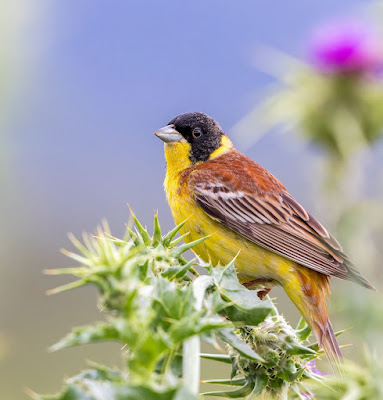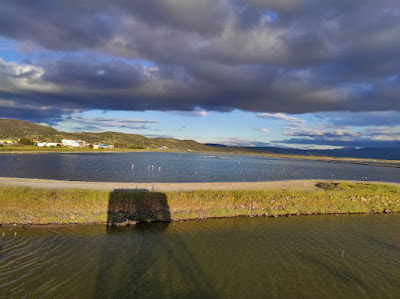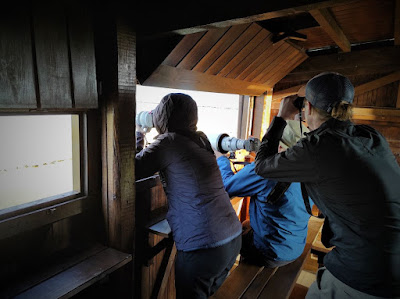LESVOS BIRDING TOUR 2023: Day 1 Trip Report
Lesvos is known worldwide for being one of the best European destinations to watch bird migration. Its strategic location between Europe, Asia and Africa blended with a great variety of habitats, make this Aegean island the perfect destination not only for birders and bird photographers, but for anyone that enjoys wildlife.
So this
year we organized a 6 day birdwatching trip around the island, during the last
week of April. We visited the most important bird areas of the island, and
tasted the delicious local cuisine, mostly sea food and local recipes. A group
of US birders and photographers joined us during the first days, while a vivid
team of Italian bird photographers and wildlife enthusiasts followed the next
couple of days. We were based in
Pasiphae Hotel at Skala Kallonis and had lunch or dinner at Dionysos Taverna by
the sea. Vehicle hirings were arranged with Tsalis Car Rental as usual, being
the most reliable car rental company of Lesvos. A special mention to Apostolis
Traditional Bakery at Skala Kallonis, providing every fresh bread every day,
handmade apple pies, greek style bagels (aka “koulouria”) and other goodies
that were bought early in the morning and kept us alive during the long days of
our birding adventures.

Birdwatchers at Metochi Lake, Lesvos

Bee-eaters at Tsiknias River, Lesvos
As an
overview, winter of 2023 was extremely hot and dry in Greece, which resulted in
a severe reduction of water in most reserves on the island. Especially the wetlands
around Skala Kallonis area were lacking water, so shorebirds and any bird
related to wetlands (terns, herons, etc) were significantly fewer compared with
previous year. On the other hand, the
rocky and more deserted part of Lesvos was full of small passerines, a very
rich avifauna in species of buntings, shrikes, warblers, chats.
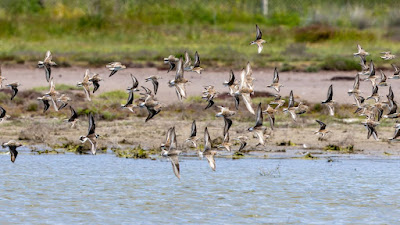
Shorebirds in flight at Kalloni Wetlands, Lesvos
Day 1:
Kalloni area and the north coast
Locations visited: Tsiknias River, Kalloni Wetlands, Kalloni Saltpans, Christou
River, Keramia village, Napi Valley, Madamados, Potamia valley, Agia Paraksevi
and minor sites.
We woke up
early in the morning from the loud calls of Nightingales and Eastern Olivaceous
Warbler around the hotels “Pasiphae” and “Aeolian Gea”. After so many years
birding in Lesvos I have concluded that the best location to start a bird trip
in the island in Tsiknias River. Nothing beats the morning sounds of
Black-headed Buntings, singing together with all Acrocephalus warblers, and in the meantime dozens of Bee-eaters sweeping
the sky or perching in the riparian vegetation. What a start!
This year
hundreds of hirundines, especially Sand Martins and Barn Swallows were flying
over Tsiknias River, since the rest part of Kalloni wetlands was relatively
dryer. It was not long until we got the first Black Stork feeding close to the
river lower ford. Nearby, a small flock of Glossy Ibises was feeding between
the reeds, along with Common Snipe, Wood Sandpipers, Little Ringed Plovers,
Black-winged Stilts. Magical!
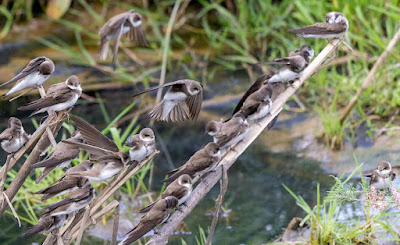
Sand Martins on migration, Tsiknias River
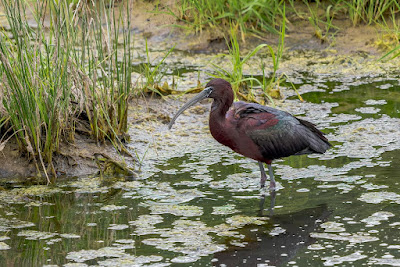
A colorful Glossy Ibis at Tsiknias River, Lesvos
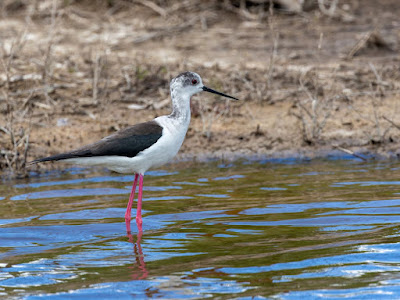
Black-winged Stilt at Kalloni Saltpans, Lesvos
Earlier in the week there were reports for a Spotted Crake in the area. Indeed we managed to see it, not far from the river bank, and had some great looks of this cryptic species. Another surprise was nearby too: a more secretive bird, a Jack Snipe! This species of snipe has a very peculiar behavior, being completely invisible when is slightly stressed. When it is more relaxed and starts feeding, it bounces up and down continuously in a truly unique way.
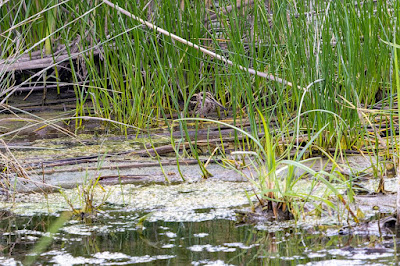
A cryptic Jack Snipe at Tsiknias River, Lesvos

Blooming fields in Kalloni, Lesvos
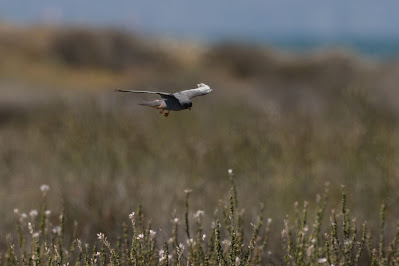
Male Red-footed Falcon hovering at Lotzaria track, Kalloni
We spent
quite a lot of time enjoying the feeding techniques of the Bee-eaters. These
striking birds are annual spring migrant and breeders, and are considered one
of the most photogenic species on the island. Another highlight at Tsiknias
River was the immense flocks of Spanish Sparrow close to the river mouth. They
were so noisy, moving from tamarisks to the group and back, probably more than
a few hundred birds.
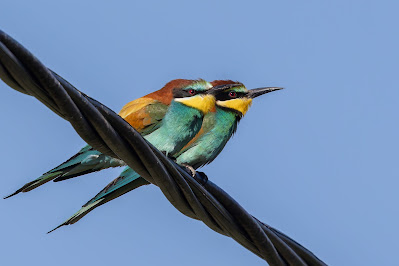
Bee-eaters on wire at Tsiknias River
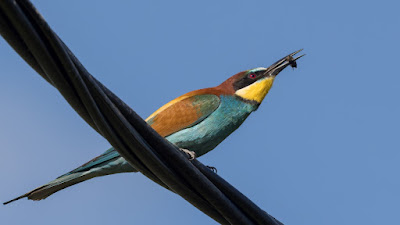
Bee-eater with insect prey at Tsiknias River

Spanish Sparrow on bloomed Tamarisks
at Tsiknias River mouth, Lesvos
Our next
stop was the area around Kalloni Saltpans. It includes Lotzaria track, the
abandoned horse-race track, and the surrounding fields. We briefly saw a female
Montagu’s Harrier, but had very good views of Ruddy Shelducks, Greater
Flamingos, Pied Avocets, Curlew Sandpipers, and the colorful Red-throated
Pipits. We used the observation towers a few times, in order to have a more
panoramic view and be able to enjoy the whole wetland area from a more elevated
point.

Ruddy Shelduck, a stunning species of waterfowl
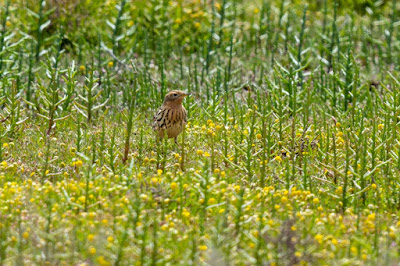
Red-throated Pipit at Kalloni horsetrack
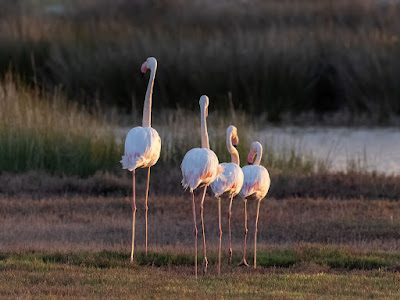
"The pink Daltons": Flamingos in perpective
Lunch at
Dionysos taverna at the pitoresque harbor of Skala Kallonis, was a big
temptation that we could not resist. Excellent sea food by the calm sea, served
with cold, Greek micro-brewery beer. We decided not to have a dessert, instead
we headed at Keramia in search of the breeding Scops Owl. We found a single
bird covered from the eucalyptus canopy, but managed to see a couple of more
during the next days.
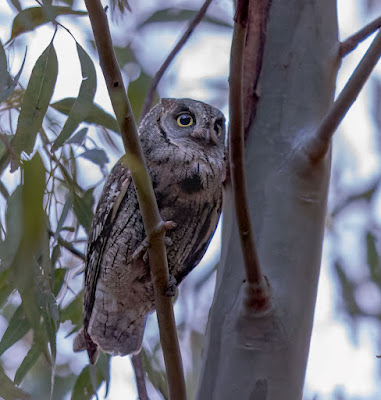
Scops Owl at Keramia village, Skala Kallonis
It was time
to hit the north coast, so we drove a few minutes towards Napi Valley. I just
love this big area of olive orchards, mixed with oak trees, in a rocky terrain.
We enjoyed a very tame Eastern Black-eared Wheatear that was posing just for
us, only a few meters away from our car. An impressive Short-towed Eagle was
hovering up in the sky, together with Long-legged Buzzards. Eastern Olivaceous
Warblers and Sombre Tits were heard during all afternoon.
After 6pm, we were reaching the “golden hour” of bird photography, so visiting the wetland was a “must”. We had a panoramic view of most of Skala Kallonis lagoons, were Pied Avocets were feeding among Greater Flamingos. A small group of Spoonbills was present too, being the last of wader we saw during this first superb day of birding.
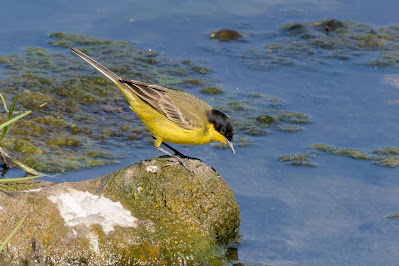
Black-headed Wagtail (Motacilla feldegg)
at Kalloni Saltpans
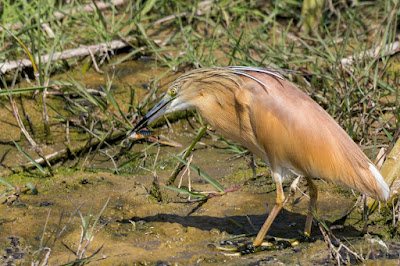
Squacco Heron just catched a fish
at Tsiknias River
Here is the bird list from Day 1
Ruddy Shelduck
Common Shelduck
Greater Flamingo
Collared Dove
Common Swift
Pallid Swift
Common Moorhen
Spotted Crake
Little Crake
Coot
Black-winged Stilt
Pied Avocet
Common Ringed Plover
Ruff
Curlew Sandpiper
Dunlin
Little Stint
Wood Sandpiper
Jack Snipe
Yellow-legged Gull
Common Tern
Sandwitch Tern
White-winger Black Tern
Black Stork
White Stork
Great Cormorant
European Shag
Little Egret
Glossy Ibis
Eurasian Spoonbill
Short-toed Eagle
Eurasian Sparrowhawk
Montagu's Harrier
Scops Owl
Hoopoe
Bee-eater
Middle-Spotted Woodpecker
Common Kestrel
Red-footed Falcon
Red-backed Shrike
Eurasian Jay
Hooded Crow
Common Raven
Blue Tit
Great Tit
Crested Lark
Eastern Olivaceous Warbler
Common Reed Warbler
Red-rumped Swallow
Barn Swallow
Sand Martin
House Martin
Cetti's Warbler
Eurasian Blackbird
Common Nightingale
Whinchat
Eastern Black-eared Wheatear
House Sparrow
Spaninsh Sparrow
Yellow Wagtail
Black-headed Wagtail
Red-throated Pipit
Common Chaffinch
European Greenfinch
European Goldfinch
Black-headed Bunting
Corn Bunting
Spyros Skareas
Bird Guide and Certified Tour Leader
Athens, GREECE
All sightings available at my eBird profile

